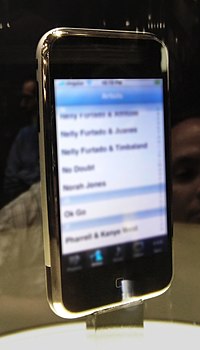Gadget
This article has multiple issues. Please help improve it or discuss these issues on the talk page. (Learn how and when to remove these messages)
No issues specified. Please specify issues, or remove this template. |
- This is an article about gadgets. For Wikipedia Gadgets go to Wikipedia:Gadget.

A gadget is a small[1] technological object (such as a device or an appliance) that has a particular function, but is often thought of as a novelty. Gadgets are invariably considered to be more unusually or cleverly designed than normal technology at the time of their invention. Gadgets are sometimes also referred to as gizmos.
History
The origins of the word "gadget" trace back to the 1800s. According to the Oxford English Dictionary, there is anecdotal evidence for the use of "gadget" as a placeholder name for a technical item whose precise name one can't remember since the 1850s; with Robert Brown's 1886 book Spunyarn and Spindrift, A sailor boy’s log of a voyage out and home in a China tea-clipper containing the earliest known usage in print.[2] The etymology of the word is disputed. A widely circulated story holds that the word gadget was "invented" when Gaget, Gauthier & Cie, the company behind the casting of the Statue of Liberty (1886), made a small-scale version of the monument and named it after their firm; however this contradicts the evidence that the word was already used before in nautical circles, and the fact that it did not become popular until after World War I.[2] Other sources cite a derivation from the French gâchette which has been applied to various pieces of a firing mechanism, or the French gagée, a small tool or accessory.[2] The spring-clip used to hold the base of a vessel during glass-making is also known as a gadget.[citation needed] The first atomic bomb was nicknamed the gadget by the scientists of the Manhattan Project, tested at the Trinity site.
Mechanical gadgets
Clocks, bicycles, and thermometers are amongst the very large number of gadgets that are mechanical and also very popular. The invention of mechanical gadgets though is based more on innovation of the inventor rather than education. [citation needed]
Electronic gadgets
Electronic gadgets are based on transistors and integrated circuits. Unlike the mechanical gadgets one needs a source of electric power to use it. The most common electronic gadgets include transistor radio, television, cell phones and the quartz watch.
Programmable gadgets
Most of the modern gadgets belong to this category. These gadgets are invariably based on a microprocessor and often have flash memory. [citation needed] They use embedded software which controls their functions. Such gadgets are found not only in the pockets of gadget freaks, but also in their cars and homes. Some examples of gadgets in this category are notebook computer, mobile phone etc.
Application gadgets
Computer programs that provide services without needing an independent application to be launched for each one, but instead run in an environment that manages multiple gadgets. There are several implementations based on existing software development techniques, like JavaScript, form input, and various image formats.
The earliest[citation needed] documented use of the term gadget in context of software engineering was in 1985 by the developers of AmigaOS, the operating system of the Amiga computers (intuition.library and also later gadtools.library). It denotes what other technological traditions call GUI widget—a control element in graphical user interface. This naming convention remains in continuing use (as of 2008) since then.
It is not known whether other software companies are explicitly drawing on that inspiration when featuring the word in names of their technologies or simply referring to the generic meaning. The word widget is older in this context.
- See: Workbench (AmigaOS)
See also
References
- ^ gadget - Definitions from Dictionary.com
- ^ a b c Michael Quinion: World Wide Words: Gadget (accessed February 6, 2008) Also in: Michael Quinion: Port Out, Starboard Home: The Fascinating Stories We Tell About the Words We Use. ISBN 978-0141012230
